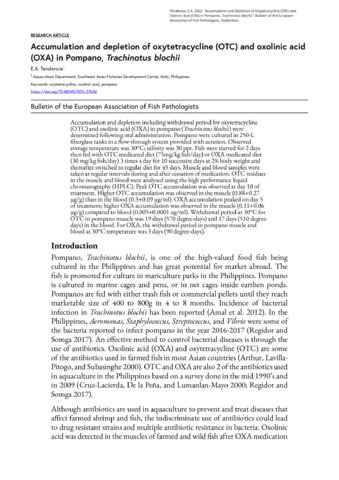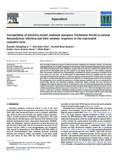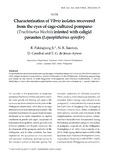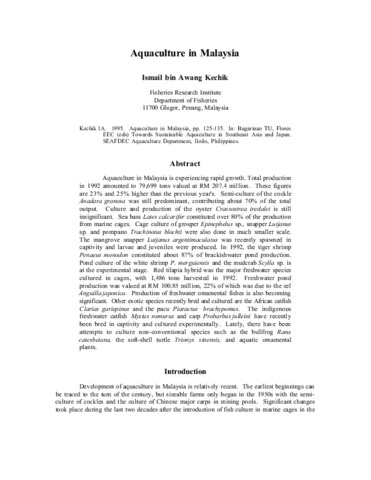Accumulation and depletion of oxytetracycline (OTC) and oxolinic acid (OXA) in Pompano, Trachinotus blochii
- Global styles
- MLA
- Vancouver
- Elsevier - Harvard
- APA
- Help

Download URL
eafpbulletin.scholasticahq.com日付
2022-09-03Page views
1,374ASFA keyword
AGROVOC keyword
Taxonomic term
Geographic names
Metadata
アイテムの詳細レコードを表示する
Share
抄録
Accumulation and depletion including withdrawal period for oxytetracycline (OTC) and oxolinic acid (OXA) in pompano (Trachinotus blochii) were determined following oral administration. Pompano were cultured in 250-L fiberglass tanks in a flow-through system provided with aeration. Observed average temperature was 30°C; salinity was 30 ppt. Fish were starved for 2 days then fed with OTC medicated diet (75mg/kg fish/day) or OXA medicated diet (30 mg/kg fish/day) 3 times a day for 10 successive days at 2% body weight and thereafter switched to regular diet for 45 days. Muscle and blood samples were taken at regular intervals during and after cessation of medication. OTC residues in the muscle and blood were analysed using the high performance liquid chromatography (HPLC). Peak OTC accumulation was observed at day 10 of treatment. Higher OTC accumulation was observed in the muscle (0.88+0.27 µg/g) than in the blood (0.3+0.09 µg/ml). OXA accumulation peaked on day 5 of treatment; higher OXA accumulation was observed in the muscle (0.11+0.06 µg/g) compared to blood (0.005+0.0001 ug/ml). Withdrawal period at 30°C for OTC in pompano muscle was 19 days (570 degree-days) and 17 days (510 degree-days) in the blood. For OXA, the withdrawal period in pompano muscle and blood at 30°C temperature was 3 days (90 degree-days).
Suggested Citation
Tendencia, E. A. (2022). Accumulation and depletion of oxytetracycline (OTC) and oxolinic acid (OXA) in Pompano, Trachinotus blochii. Bulletin of the European Association of Fish Pathologists. https://doi.org/10.48045/001c.37646
Type
ArticleISSN
0108-0288Collections
- Journal Articles [1258]
Related items
Showing items related by title, author, creator and subject.
-
Susceptibility of hatchery-reared snubnose pompano Trachinotus blochii to natural betanodavirus infection and their immune responses to the inactivated causative virus
Pakingking, Rolando V., Jr. ; Mori, Koh-Ichiro; Bautista, Norwell Brian; de Jesus-Ayson, Evelyn Grace; Reyes, Ofelia (Elsevier, 2011)
Mass mortality of snubnose pompano Trachinotus blochii fry exhibiting dark coloration, anorexia, and abnormal swimming behavior was recently documented at the hatchery of the Aquaculture Department of the Southeast Asian ...
; Mori, Koh-Ichiro; Bautista, Norwell Brian; de Jesus-Ayson, Evelyn Grace; Reyes, Ofelia (Elsevier, 2011)
Mass mortality of snubnose pompano Trachinotus blochii fry exhibiting dark coloration, anorexia, and abnormal swimming behavior was recently documented at the hatchery of the Aquaculture Department of the Southeast Asian ... -
Characterisation of Vibrio isolates recovered from the eyes of cage-cultured pompano (Trachinotus blochii) infested with caligid parasites (Lepeophtheirus spinifer)
Pakingking, Rolando V., Jr. ; Bautista, Norwell B.; Catedral, Demy; de Jesus-Ayson, Evelyn Grace (European Association of Fish Pathologists, 2018)
Exophthalmia was documented among sea cage-cultured pompano (Trachinotus blochii) broodstocks with caligid parasite (Lepeophtheirus spinifer) infestation in the Philippines. Following sequencing, and based on the results ...
; Bautista, Norwell B.; Catedral, Demy; de Jesus-Ayson, Evelyn Grace (European Association of Fish Pathologists, 2018)
Exophthalmia was documented among sea cage-cultured pompano (Trachinotus blochii) broodstocks with caligid parasite (Lepeophtheirus spinifer) infestation in the Philippines. Following sequencing, and based on the results ... -
Aquaculture in Malaysia
Kechik, Ismail bin Awang. (Aquaculture Department, Southeast Asian Fisheries Development Center, 1995)Aquaculture in Malaysia is experiencing rapid growth. Total production in 1992 amounted to 79,699 tons valued at RM 207.4 million. These figures are 23% and 25% higher than the previous year's. Semi-culture of the cockle ...






